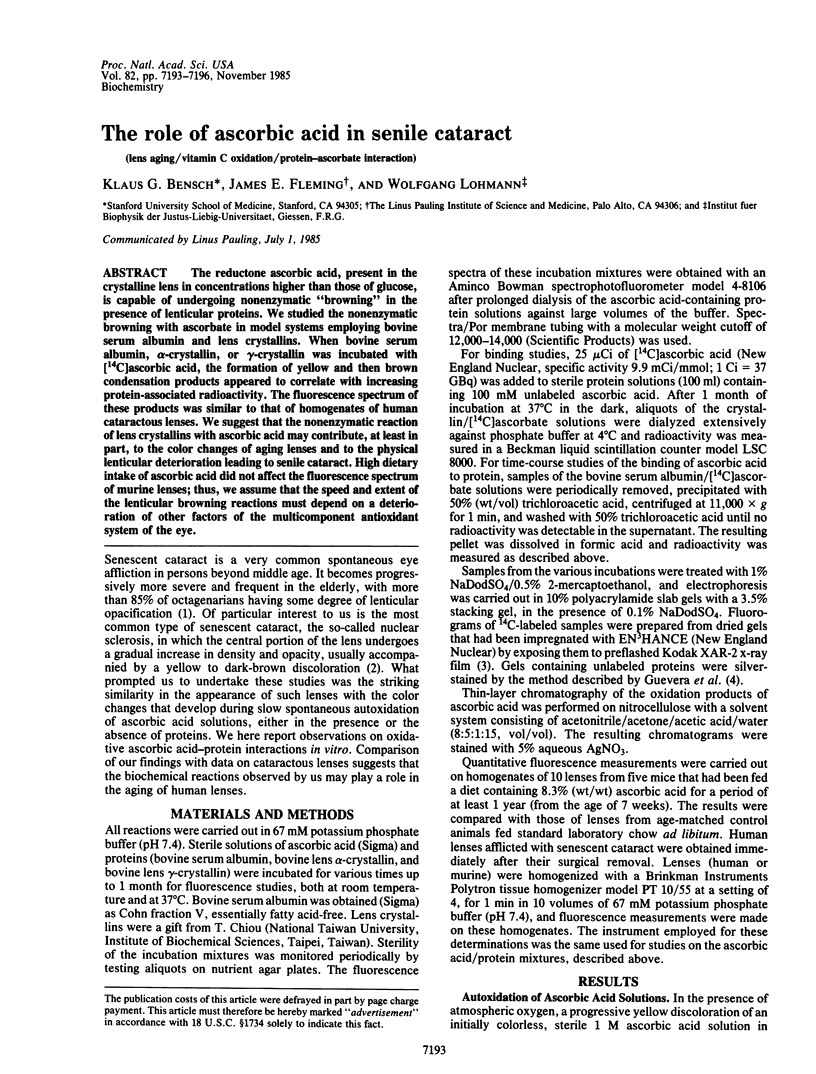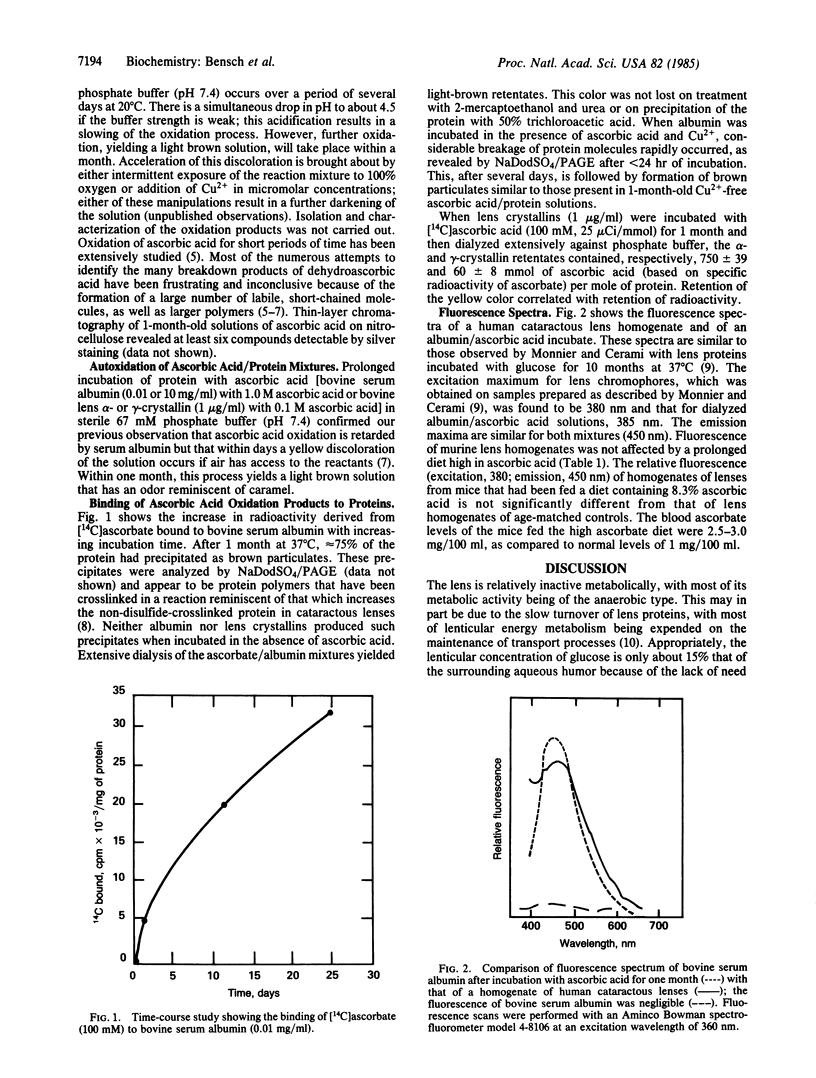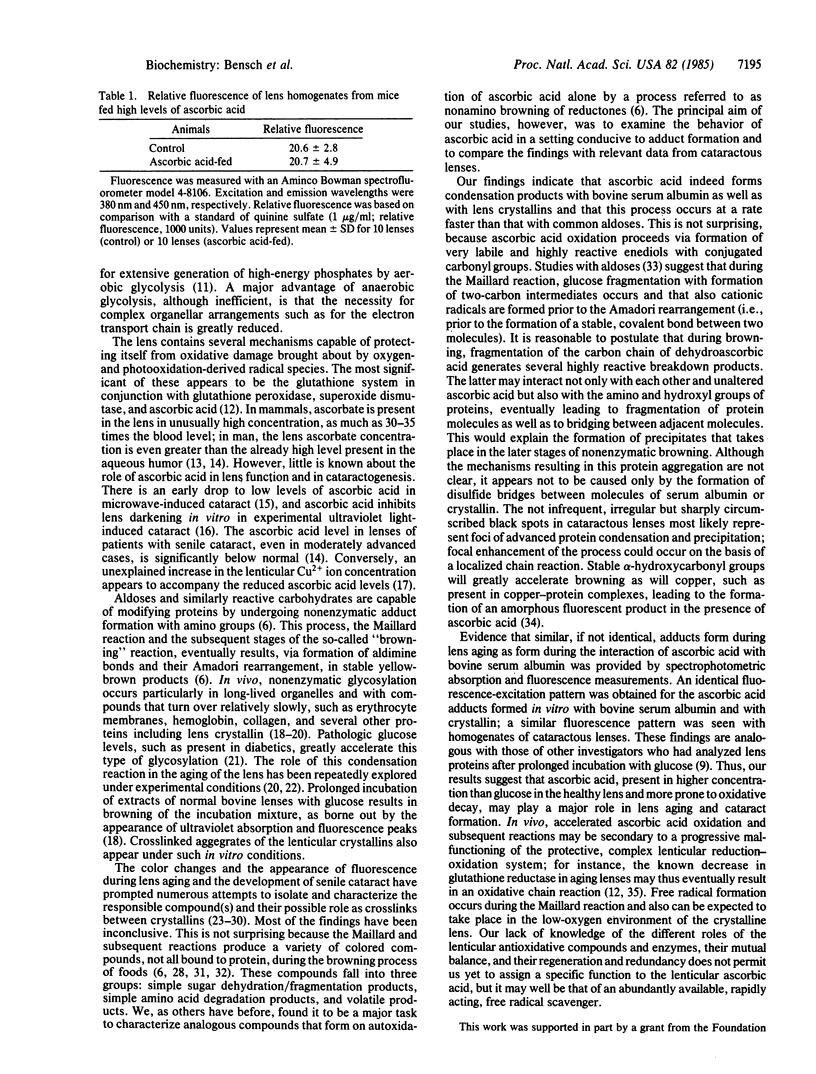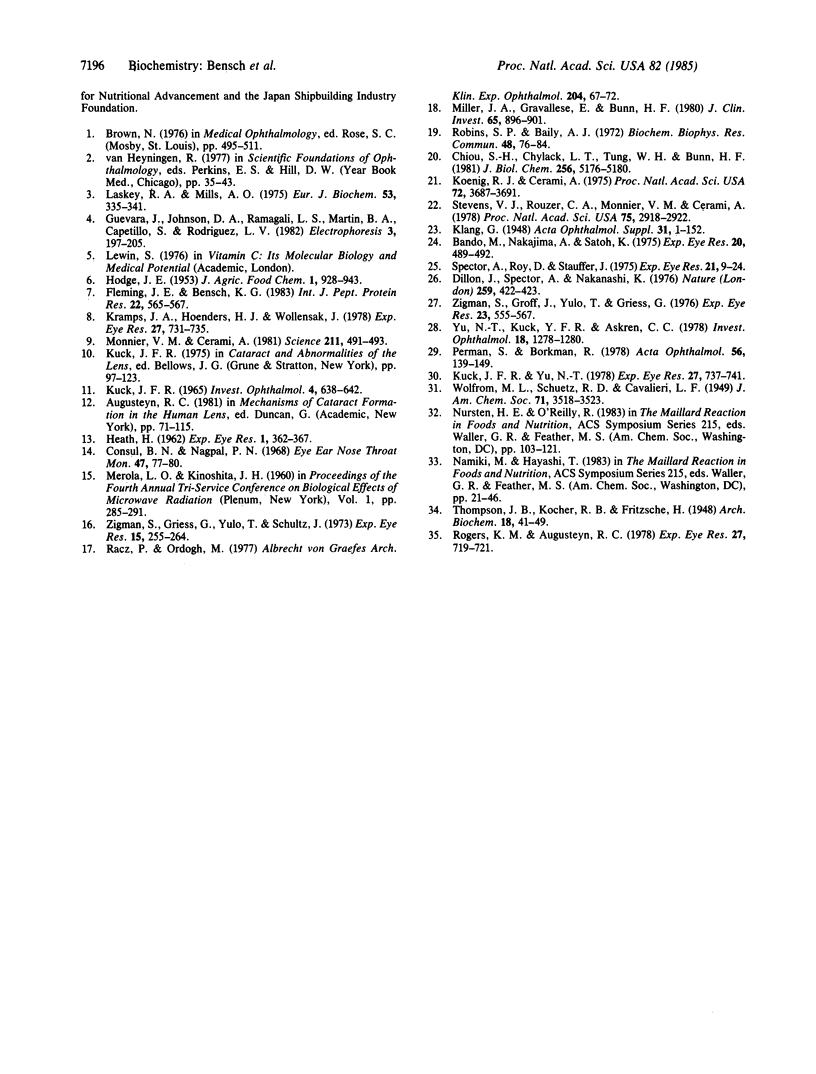Abstract
The reductone ascorbic acid, present in the crystalline lens in concentrations higher than those of glucose, is capable of undergoing nonenzymatic "browning" in the presence of lenticular proteins. We studied the nonenzymatic browning with ascorbate in model systems employing bovine serum albumin and lens crystallins. When bovine serum albumin, alpha-crystallin, or gamma-crystallin was incubated with [14C]ascorbic acid, the formation of yellow and then brown condensation products appeared to correlate with increasing protein-associated radioactivity. The fluorescence spectrum of these products was similar to that of homogenates of human cataractous lenses. We suggest that the nonenzymatic reaction of lens crystallins with ascorbic acid may contribute, at least in part, to the color changes of aging lenses and to the physical lenticular deterioration leading to senile cataract. High dietary intake of ascorbic acid did not affect the fluorescence spectrum of murine lenses; thus, we assume that the speed and extent of the lenticular browning reactions must depend on a deterioration of other factors of the multicomponent antioxidant system of the eye.
Full text
PDF



Selected References
These references are in PubMed. This may not be the complete list of references from this article.
- Bando M., Nakajima A., Satoh K. Coloration of human lens protein. Exp Eye Res. 1975 May;20(5):489–492. doi: 10.1016/0014-4835(75)90089-5. [DOI] [PubMed] [Google Scholar]
- Chiou S. H., Chylack L. T., Jr, Tung W. H., Bunn H. F. Nonenzymatic glycosylation of bovine lens crystallins. Effect of aging. J Biol Chem. 1981 May 25;256(10):5176–5180. [PubMed] [Google Scholar]
- Dillon J., Spector A., Nakanishi K. Identification of beta carbolines isolated from fluorescent human lens proteins. Nature. 1976 Feb 5;259(5542):422–423. doi: 10.1038/259422a0. [DOI] [PubMed] [Google Scholar]
- Fleming J. E., Bensch K. G. Conformational changes of serum albumin induced by ascorbic acid. Int J Pept Protein Res. 1983 Nov;22(5):565–567. doi: 10.1111/j.1399-3011.1983.tb02129.x. [DOI] [PubMed] [Google Scholar]
- KUCK J. F., Jr CARBOHYDRATES OF THE LENS IN NORMAL AND PRECATARACTOUS STATES. Invest Ophthalmol. 1965 Aug;4:638–642. [PubMed] [Google Scholar]
- Koenig R. J., Cerami A. Synthesis of hemoglobin AIc in normal and diabetic mice: potential model of basement membrane thickening. Proc Natl Acad Sci U S A. 1975 Sep;72(9):3687–3691. doi: 10.1073/pnas.72.9.3687. [DOI] [PMC free article] [PubMed] [Google Scholar]
- Kramps J. A., Hoenders H. J., Wollensak J. Increase of non-disulphide cross-links during progress of nuclear cataract. Exp Eye Res. 1978 Dec;27(6):731–735. doi: 10.1016/0014-4835(78)90044-1. [DOI] [PubMed] [Google Scholar]
- Kuck J. F., Jr, Yu N. T. Raman and fluorescent emission of the human lens. A new fluorophor. Exp Eye Res. 1978 Dec;27(6):737–741. doi: 10.1016/0014-4835(78)90045-3. [DOI] [PubMed] [Google Scholar]
- Laskey R. A., Mills A. D. Quantitative film detection of 3H and 14C in polyacrylamide gels by fluorography. Eur J Biochem. 1975 Aug 15;56(2):335–341. doi: 10.1111/j.1432-1033.1975.tb02238.x. [DOI] [PubMed] [Google Scholar]
- Lerman S., Borkman R. Ultraviolet radiation in the aging and cataractous lens. A survey. Acta Ophthalmol (Copenh) 1978 Feb;56(1):139–149. doi: 10.1111/j.1755-3768.1978.tb00476.x. [DOI] [PubMed] [Google Scholar]
- Miller J. A., Gravallese E., Bunn H. F. Nonenzymatic glycosylation of erythrocyte membrane proteins. Relevance to diabetes. J Clin Invest. 1980 Apr;65(4):896–901. doi: 10.1172/JCI109743. [DOI] [PMC free article] [PubMed] [Google Scholar]
- Monnier V. M., Cerami A. Nonenzymatic browning in vivo: possible process for aging of long-lived proteins. Science. 1981 Jan 30;211(4481):491–493. doi: 10.1126/science.6779377. [DOI] [PubMed] [Google Scholar]
- Robins S. P., Bailey A. J. Age-related changes in collagen: the identification of reducible lysine-carbohydrate condensation products. Biochem Biophys Res Commun. 1972 Jul 11;48(1):76–84. doi: 10.1016/0006-291x(72)90346-4. [DOI] [PubMed] [Google Scholar]
- Rogers K. M., Augusteyn R. C. Glutathione reductase in normal and cataractous human lenses. Exp Eye Res. 1978 Dec;27(6):719–721. doi: 10.1016/0014-4835(78)90041-6. [DOI] [PubMed] [Google Scholar]
- Rácz P., Ordögh M. Investigations on trace elements in normal and senile cataractous lenses. Activation analysis of copper, zinc, manganese, cobalt, rubidium, scandium, and nickel. Albrecht Von Graefes Arch Klin Exp Ophthalmol. 1977 Sep 30;204(1):67–72. doi: 10.1007/BF02387418. [DOI] [PubMed] [Google Scholar]
- Spector A., Roy D., Stauffer J. Isolation and characterization of an age-dependent polypeptide from human lens with non-tryptophan fluorescence. Exp Eye Res. 1975 Jul;21(1):9–24. doi: 10.1016/0014-4835(75)90053-6. [DOI] [PubMed] [Google Scholar]
- Stevens V. J., Rouzer C. A., Monnier V. M., Cerami A. Diabetic cataract formation: potential role of glycosylation of lens crystallins. Proc Natl Acad Sci U S A. 1978 Jun;75(6):2918–2922. doi: 10.1073/pnas.75.6.2918. [DOI] [PMC free article] [PubMed] [Google Scholar]
- Yu N. T., Kuck J. F., Jr, Askren C. C. Red fluorescence in older and brunescent human lenses. Invest Ophthalmol Vis Sci. 1979 Dec;18(12):1278–1280. [PubMed] [Google Scholar]
- Zigman S., Griess G., Yulo T., Schultz J. Ocular protein alterations by near UV light. Exp Eye Res. 1973 Mar;15(3):255–264. doi: 10.1016/0014-4835(73)90145-0. [DOI] [PubMed] [Google Scholar]
- Zigman S., Groff J., Yulo T., Griess G. Light extinction and protein in lens. Exp Eye Res. 1976 Nov;23(5):555–567. doi: 10.1016/0014-4835(76)90163-9. [DOI] [PubMed] [Google Scholar]


